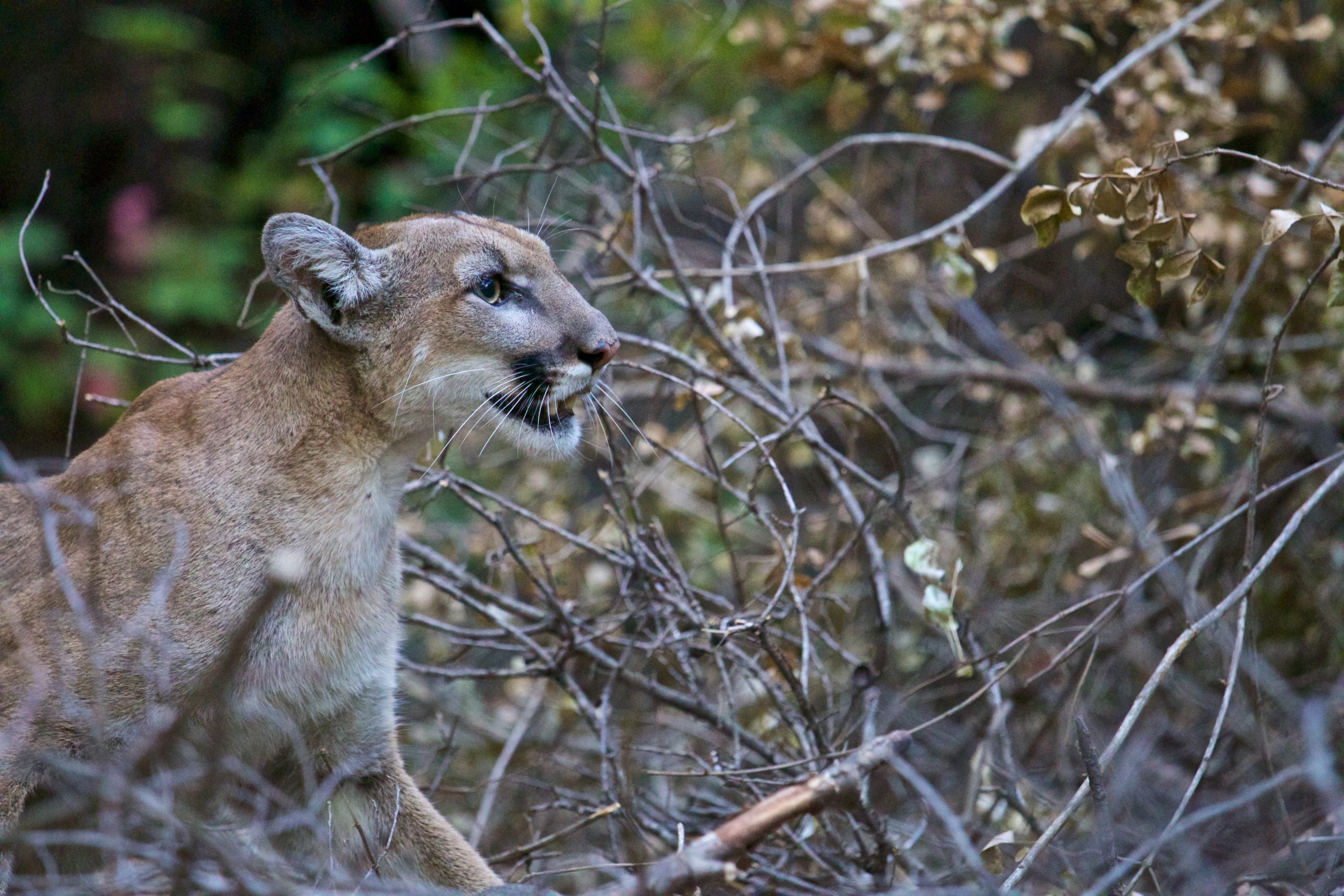UPDATE – March 2023: As of March 20, 89 cougars have died in Oregon in 2023. In July 2023, there will be the opportunity to submit public comments to the Commission regarding cougar hunting in the state. As the time approaches, be sure to tune in for talking points with the Mountain Lion Foundation when proposals are released. Until then please feel free to reach out to your commissioners letting them know that preserving the cougar population in Oregon is important to you.
Talking Points
-
- You would like the commission to reduce the 970 mortality limit to 12% of the 18-month and older cougar population.
- You would like to see a summer hunting season closure during the summer to help protect kittens when they are most likely to be denning.
- What wildlife means to you as an Oregon resident and your hopes that the Commission will support that.
Legal Status
- Classified as a game animal.
- 1994: Voters passed Measure 18, banning the use of hounds to hunt cougars
Estimated population: ODFW lists the population at 6,000. ODFW reports some of the highest cougar densities in the U.S., but this is highly controversial. Unlike other states, ODFW includes kittens in its estimate. ODFW estimates their population by using a model that factors densities, habitat suitability, and mortality. While hunting has increased, the model has predicted an ever-increasing population size. This model has not been verified, in small areas where abundance data can be obtained. It is imperative that the ODFW updates and tests its model to ensure its accuracy, so cougars can be managed appropriately.
Annual trophy kills: 327 in 2019
Oregon’s first Cougar Management Plan was developed in 1987 with revisions in 1993, 1998, 2006, and 2017. According to a 2008 ODFW report on the status of Oregon’s cougars, the 2006 revision established “5 guiding objectives for cougar management in Oregon:
- ODFW will manage for a cougar population that is at or above the 1994 level of approximately 3,000 cougars statewide.
- ODFW will proactively manage cougar-human conflicts as measured by non-hunting mortalities and ODFW may take management actions to reduce the cougar population.
- ODFW will proactively manage cougar-human safety/pet conflicts as measured by human safety/pet complaints and ODFW may take management action to reduce the cougar population.
- ODFW will proactively manage cougar-livestock conflicts as measured by non-hunting mortalities and livestock damage complaints and ODFW may take management actions to reduce the cougar population.
- ODFW will proactively manage cougar populations in a manner compatible and consistent with management objectives for other game mammals outlined in ODFW management plans.
Within these objectives, a number of zone-specific criteria are established that trigger management actions and are used to monitor progress toward objectives. Proactive management of cougars may include intensive, administrative removal of cougars in targeted areas where zone specific criteria have been met.”
As you can see, “proactive management,” while sounding responsible and scientific, merely means “reduce the cougar population.” ODFW’s so-called proactive cougar management plan is in reality a set of directives for the elimination of the species in Oregon. We believe that ODFW’s statement of intent to maintain Oregon’s cougar population at 1994 levels is a public relations attempt to placate Measure 18 supporters and is little more than a meaningless slogan to justify the killings.
Their management plan is fundamentally flawed because:
- First, ODFW’s 1994 population estimate of 3,000 cougars is in dispute. A 1997 report by the Predator Defense Institute enumerated numerous deficiencies in the statewide cougar population estimates formulated by ODFW and argued that the agency biased its reporting of cougar sightings and incidents to support claims that the cougar population was growing significantly.
- Second, ODFW is basing its current actions to aggressively reduce Oregon’s cougar population on a crude computer model which does not accurately reflect the complexity of what is happening on the ground.
Today, ODFW’s estimate of 6,600 cougars in Oregon would indicate a cougar density roughly 2.5 times that of neighboring Washington and is widely believed by biologists to be overstated. Given the available habitat and results from scientific research conducted in Washington showing roughly 5 independent cougars per 100 square miles, the Mountain Lion Foundation would estimate fewer than 3,000 independent adult cougars in the State of Oregon.
Arguments Disputing ODFW’s Cougar Population Estimate
Between 1918 and 1961 (Oregon’s recorded cougar bounty period) 6,762 cougar carcasses were turned in for a bounty. During this 44-year period, the annual cougar mortality numbers only exceeded the 300 level three times, with the all time high of 375 reached in 1937. In fact, the 200 to 300 mortality level was reached only eight times. For almost a third of this 44-year period the annual cougar mortality numbers never even reached 100; and this wasn’t just at the end when Oregon’s cougar population had basically been wiped out.
A comparable time period of regulated hunting has now passed (1967 to 2009 — the last year of records released by ODFW). During these 43-years, 7,468 cougars (4) were reported killed.
In 2008 neighboring Washington state (which in 1996 passed similar legislation to Measure 18, and whose state wildlife agency followed ODFW’s game plan of numerous, cheap cougar hunting tags and long hunt seasons) reported a nearly 40 percent drop in the state’s cougar population from five years previous.(5) The Washington Department of Fish and Wildlife posits that this drastic decline might be a direct result of current hunting policies which have caused a “shift to harvesting more females and younger animals.”
The questions one must ask are these:
- If killing 6,762 cougars over a 44-year time period once almost wiped out the cougar population in Oregon, why does ODFW believe that killing 7,468 cougars over the past 43 years of regulated cougar hunting hasn’t produced similar results?
- If a nearby state with similar habitat (Washington) has the same cougar hunting restrictions, as well as analogous cougar hunting policies (without the additional administrative removal plan), and that state’s policies and actions have resulted in a significant reduction in their cougar population, why does ODFW believe that similar results are not taking place in Oregon?
Citations
- APHIS 2008 Oregon Report
- Extirpate – syn exterminate; 1) to pull up by the roots; root out; 2) to destroy or remove completely; exterminate; extinguish; abolish; 3) the local extinction of a species.
- Non-Hunter Harvest numbers include depredation kills; administrative removals; public safety actions.
- Includes Non-Hunter Harvest numbers
- ODFW 2003 max estimate 4,000 cougars, 2008 max estimate 2,500 cougars





 The state of Oregon encompasses 95,996 square miles of land. Of this, the Oregon Department of Fish and Wildlife (ODFW) claim that 71,997 square miles, or 75 percent of the state, is suitable cougar habitat.
The state of Oregon encompasses 95,996 square miles of land. Of this, the Oregon Department of Fish and Wildlife (ODFW) claim that 71,997 square miles, or 75 percent of the state, is suitable cougar habitat.